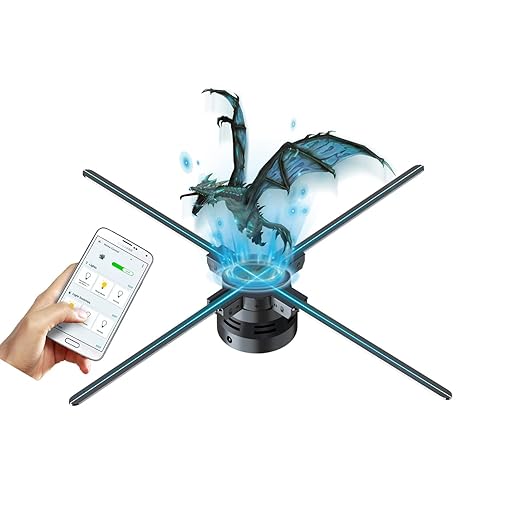Imagine stepping into a world where 3D holographic images materialize in thin air, captivating your senses and imagination. The advent of 3D hologram fans has brought us closer to that surreal experience, revolutionizing the way we perceive and interact with visual content. In this article, we will delve into the mesmerizing world of 3D hologram fans and explore how they are reshaping industries and everyday life.
What is a 3D Hologram Fan?
Before we dive into the intricacies of 3D hologram fans, let’s understand what they are. A 3D hologram fan is a device that employs a combination of LED lights and blades to create the illusion of 3D images floating in the air. These images can be anything from product visuals to intricate animations and even live performances.
How do 3D Hologram Fans Work?
3D hologram fans use a concept known as “Pepper’s Ghost.” Essentially, they project light onto a spinning set of blades, creating a mesmerizing visual effect. The result is a holographic image that appears three-dimensional to the viewer, even though it’s just a projection.
The Evolution of Holographic Technology
To appreciate the significance of 3D hologram fans, we need to take a quick journey through the evolution of holographic technology. From its inception as a photographic technique to the sophisticated holograms of today, technology has come a long way.
Read another Futuristic Smart Card Details – The Rise of NFC Business Cards in Modern Networking
Applications of 3D Hologram Fans
Entertainment Industry and Led Fan
3D hologram fans have found a substantial place in the entertainment industry. Artists can now perform on stage as 3D holograms, blurring the line between reality and illusion. Michael Jackson’s posthumous holographic performance at the 2014 Billboard Music Awards is a notable example.
Advertising and Marketing
In the world of advertising and marketing, 3D hologram fans have become a game-changer. Imagine a product launch where your new gadget materializes in the form of a hologram, capturing the audience’s attention in an unprecedented manner.
Education and Training
3D hologram fans are also making waves in education and training. Complex subjects can be visualized with ease, making learning more engaging and effective.
Medical and Healthcare
In the medical field, 3D hologram fans are transforming how surgeons plan and execute procedures. Detailed 3D holographic models of the human body provide a deeper understanding of anatomy and pathology.
3D Hologram Fans in Trade Shows and Events
Trade shows and events have embraced 3D hologram fans as a means to stand out in a crowded marketplace. These fans enable businesses to showcase their products and services in a captivating manner.
Holograms in Everyday Life
From interactive menus at restaurants to holographic product displays in stores, 3D hologram fans are increasingly becoming part of our daily experiences.
Advantages and Disadvantages
3D hologram fans offer numerous advantages, such as enhanced visual engagement and unique marketing opportunities. However, they also come with limitations, including cost and the need for dark environments.
The Growing Popularity of 3D Hologram Fans
The popularity of 3D hologram fans is on the rise, and we can expect to see them increasingly integrated into various sectors.
As we delve deeper into the 21st century, we can see the growing prevalence of 3D hologram fans in various aspects of life. Their popularity continues to surge, thanks to the remarkable visual experiences they offer.
For instance, in the field of advertising, 3D hologram fans have transformed the way companies promote their products and services. Imagine walking into a shopping mall and encountering a captivating holographic display of the latest fashion trends. These eye-catching presentations not only draw attention but also provide an immersive and memorable brand experience. This innovative approach to marketing has proven effective, making products more enticing to consumers.
Moreover, in the education sector, 3D hologram fans are revolutionizing the learning process. Teachers and trainers now have the ability to demonstrate complex subjects with stunning visual aids. Whether it’s dissecting a 3D holographic model of the human heart in biology class or explaining the principles of physics through holographic simulations, education has become more engaging and informative.
In the healthcare industry, 3D hologram fans are empowering medical professionals. Surgeons can plan intricate surgeries with precision, using holographic models that provide a detailed understanding of the human anatomy. This not only improves surgical outcomes but also enhances patient safety.
Furthermore, trade shows and events have embraced the captivating potential of 3D hologram fans. Businesses set up holographic displays of their products and services, creating a buzz among attendees. These fans enable companies to stand out in crowded environments, leaving a lasting impression on potential clients and customers.
The integration of holograms into everyday life is becoming more common. From interactive holographic menus at restaurants to dynamic holographic product displays in retail stores, these fans are changing the way we interact with information and products. They have the power to make even routine tasks more exciting and engaging.
The Future of Led Fan
The future of 3D hologram fans is incredibly promising. As technology continues to evolve, we can expect even more realistic and immersive holographic experiences.
Here are some exciting possibilities on the horizon:
- Enhanced Realism: Future 3D hologram fans may offer even more lifelike and convincing holographic images. This could lead to applications in virtual tourism, where users can explore destinations in a truly immersive manner.
- Widespread Use in Telecommunications: 3D hologram fans may find applications in telecommunications, enabling lifelike holographic video conferencing and virtual meetings. This could change the way we connect with others, especially in a world where remote work and communication are increasingly prevalent.
- Medical Training Advancements: Medical professionals could use highly detailed 3D holographic models for training and surgical planning, reducing the learning curve and improving patient care.
- Interactive Entertainment: Interactive holographic experiences in gaming and entertainment are a distinct possibility. Gamers might find themselves directly interacting with holographic characters and worlds.
- Holographic Shopping: In the retail sector, we might see the emergence of holographic shopping experiences, where customers can view and interact with products virtually before making a purchase decision.
Conclusion
3D hologram fans have taken the world by storm, redefining the way we experience visual content. As they continue to evolve, their impact on entertainment, advertising, education, healthcare, and more is only set to grow. Embrace this holographic revolution and get ready for a future where the line between the real and the holographic becomes beautifully blurred.
FAQs of LED Fan
- Are LED fans only used for entertainment?
- No, they have diverse applications, including education, healthcare, and marketing.
- What technology is behind hologram fans?
- They use a combination of LED lights and spinning blades to create holographic images.
- What are the advantages of using 3D hologram projector in advertising?
- They offer unique and attention-grabbing ways to showcase products and services.
- Are 3D holographic fans affordable for small businesses?
- The cost can vary, but there are options suitable for various budgets.
- How do hologram 3D fans impact everyday life?
- They are increasingly integrated into public spaces, enhancing the way we interact with information and products.
Watch our latest products Video Here






[…] may also like to read “How 3D Hologram Fans Are Changing Everything” this […]